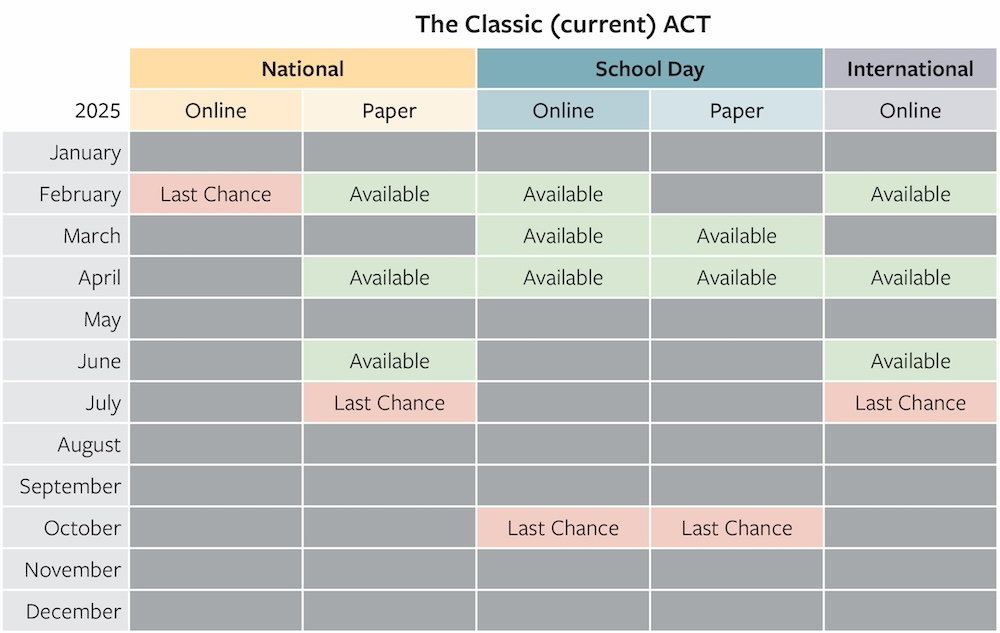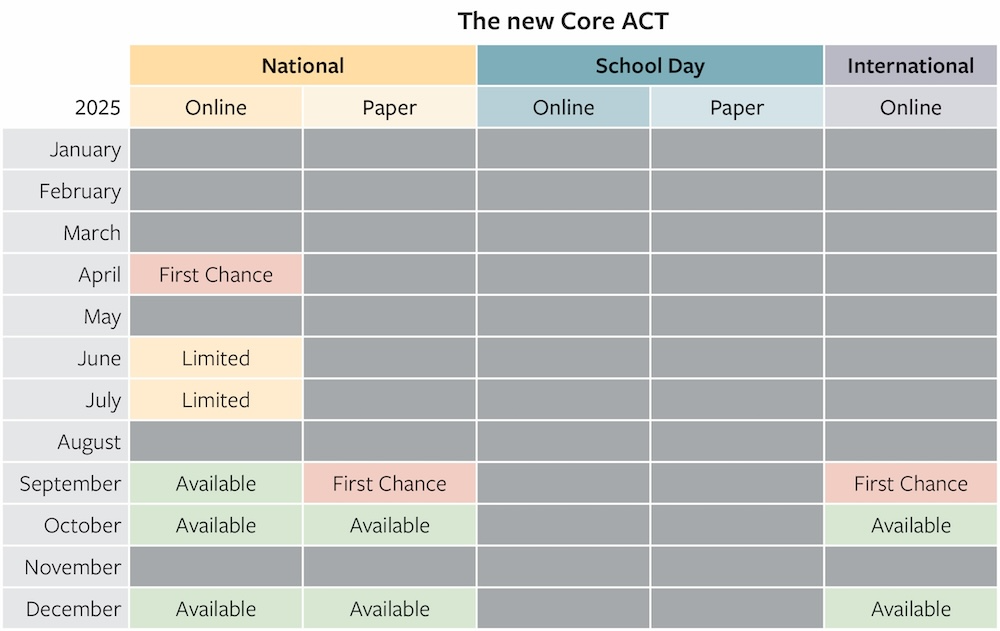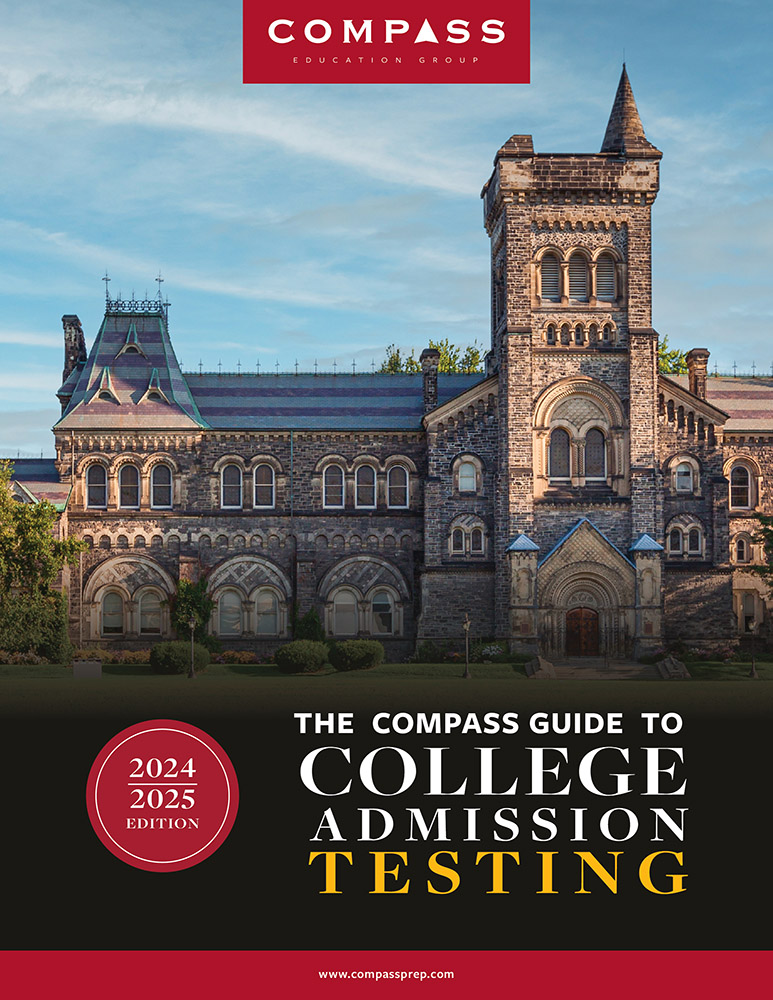 Compass Co-Founder Adam Ingersoll discusses this topic with Eric Furda, Senior Associate Director of College Counseling at William Penn Charter High School (PA) and former Dean of Admissions at UPenn, and Eileen Cunningham Feikens, Dean of College Counseling at Dwight-Englewood School (NJ), hosts of SiriusXM’s The Process. (Please listen here if you have SiriusXM, otherwise stream below.)
Compass Co-Founder Adam Ingersoll discusses this topic with Eric Furda, Senior Associate Director of College Counseling at William Penn Charter High School (PA) and former Dean of Admissions at UPenn, and Eileen Cunningham Feikens, Dean of College Counseling at Dwight-Englewood School (NJ), hosts of SiriusXM’s The Process. (Please listen here if you have SiriusXM, otherwise stream below.)
As the new “core” ACT gets phased in this year and the current “classic” version is wound down, it’s important to map out the smartest testing paths for students in the classes of 2026 and 2027. This post opens with streamlined advice for most students, followed by an in-depth discussion of upcoming changes and their implications.
Class of 2026:
- What To Do This Spring*
- Ignore the core ACT for now
- Choose between the Digital SAT or the classic paper-pencil ACT
- Take practice tests if you are still deciding
- Why Avoid the core ACT For Now?
- Very limited availability in most areas
- Lack of reliable practice tests
- Potential technical issues during spring’s “soft launch”
- Uncertain college policies on ACT science and superscoring
*Pivotal ACT Dates & Deadlines:
- Last classic ACT: July 2025 (or October for School Day testing)
- After July, transition to core ACT (with science) if necessary
- Core ACT with paper-pencil option debuts in September 2025
Class of 2027:
- What To Do This Spring
- Rest assured that colleges will accept the core ACT
- Wait for colleges’ policies on science and superscoring to resolve
- Take practice tests (Digital P/SAT and/or classic ACT)
- Classic ACT remains a valid diagnostic tool for now
- Be among the first to try a core ACT practice test, available by early March
- Looking Ahead
- By your junior year, the core ACT will be fully implemented
- Digital SAT and core ACT will be your only two options
- If you take the core ACT, include the science section
Class of 2026 In-Depth
For current 11th graders, Compass recommends choosing the Digital SAT or the classic paper-pencil ACT, as the staggered rollout of changes from April 2025 into 2026 compromises the core ACT for the class of 2026. But remember, the last chance to take the classic ACT is July 2025 (or October if your high school administers School Day testing.) If you need to test later than this, you will need to transition to the core ACT. More on that below.
By now, most college-bound juniors will be underway with their standardized testing. An ideal testing plan:
- Uses baseline diagnostics to reveal whether the SAT or ACT is a better fit
- Schedules enough time to prepare for the student’s preferred test
- Allows for at least one retest (superscoring) opportunity
- Ensures access to abundant, reliable practice material
- Produces scores that are competitive at target colleges
- Includes all scores (i.e. ACT science) that might be required or additive
The class of 2026 technically encounters three tests in this transition year: the digital SAT, the classic ACT, and the core ACT that will roll out in stages. But again, we advise limiting your options to only the first two. This table illustrates why:

PATHWAY #1: TAKE THE SAT.
The digital, adaptive SAT that debuted in March 2023 has reached a steady state. Although SAT capacity is still limited in some regions, the test is being administered on all national weekend test dates and through weekday School Day testing. We recommend registering as far in advance as possible and reserving at least two official sittings.
Students can then tailor their SAT prep around their schedule and target test dates. For test prep material, College Board and private test prep companies like Compass have plenty of high quality resources, including additional practice testing.
Finally, students can trust that their SAT score – with no optional component of uncertain relevance – will be accepted and evaluated in its entirety across the college admissions landscape wherever test scores are required or considered.
Conclusion: this is the cleanest testing pathway for the class of 2026.
PATHWAY #2: TAKE THE CLASSIC ACT.
Compass encourages the class of 2026 to stick with the classic paper-pencil ACT for as long as possible (it is available through the July national date and through October for School Day testing). The library of diagnostic exams is robust with trusted scaling. The paper version is more readily available and reliable, and many students find the digital version unwieldy. Taking the classic version also eliminates the possibility of students skipping science to their detriment.
Note: For those who would prefer an online administration of the ACT, you must first see if you can even find a test site that offers online testing. If you can, then you must confirm who will provide the testing device. Unlike the (now digital-only) SAT which has allowed students to test on their own device, the online ACT has been administered only on computers provided by the host. That restriction has substantially limited availability. ACT has recently announced plans to begin allowing students to bring their own device, but it’s not yet clear when this will go into effect. We advise students to carefully review ACT’s plans and conditions for personal and school-managed computers here before abandoning the paper option.
This matrix of restrictive conditions is important for students and their advisors to work through for the class of 2026 students who prefer the ACT. We summarize the wind-down of the classic ACT in this chart:
 Plenty of high-quality test prep material exists for the classic ACT, and all components of the classic ACT will be fully reported and evaluated across the college admissions landscape wherever test scores are required or considered.
Plenty of high-quality test prep material exists for the classic ACT, and all components of the classic ACT will be fully reported and evaluated across the college admissions landscape wherever test scores are required or considered.
Conclusion: as long as a student is clear on when the last chance to take their preferred format (online or paper-pencil) of the classic ACT will occur, they can craft their test prep timelines by backcasting from that final date. If a student then chooses to retake the ACT after the classic version is no longer offered, they will need to shift to the new core ACT. This should be a smooth process, since most of the previous preparation will apply to the new test. Some calibration to changes in question types and pacing will be necessary, but this is a safe pathway for those who wish to avoid the SAT.
PATHWAY #3: WAIT FOR THE CORE ACT.
ACT’s changes may sound appealing and worth the wait—fewer questions, optional science, and improved pacing—but the staggered and deferred timing of the rollout is suboptimal for the class of 2026. The potential benefits of the overhaul are more aligned with the normal testing timeline for the class of 2027.
Moreover, the gradual rollout of the core ACT will prevent this pathway from being a viable option for many class of 2026 students anyway, due to a lack of access to test sites on optimal or critical dates. This chart illustrates the schedule for unveiling the core ACT: The great majority of US students in the class of 2026 will avoid the core ACT, either by circumstance or by choice. Only those who can secure a) a seat at b) a site offering the online version on c) a national date will access the core ACT while still in 11th grade. And even then, ACT’s early-stage online testing platform currently lags significantly behind College Board’s SAT app for usability and features. Those who plan to take the core ACT on paper must wait until September of senior year. Those who plan to take a School Day ACT (a weekday administration held by a school only for its own students) will not be offered the core ACT on a School Day administration, as School Day testing remains the classic version until the spring of 2026 (when the class of 2027 is in 11th grade.)
The great majority of US students in the class of 2026 will avoid the core ACT, either by circumstance or by choice. Only those who can secure a) a seat at b) a site offering the online version on c) a national date will access the core ACT while still in 11th grade. And even then, ACT’s early-stage online testing platform currently lags significantly behind College Board’s SAT app for usability and features. Those who plan to take the core ACT on paper must wait until September of senior year. Those who plan to take a School Day ACT (a weekday administration held by a school only for its own students) will not be offered the core ACT on a School Day administration, as School Day testing remains the classic version until the spring of 2026 (when the class of 2027 is in 11th grade.)
Test prep content and methods for the core ACT will not be drastically different, as the format and structural changes for the core exam are modest in scope. And while there will eventually be a deep bank of core practice tests, they are another important component of preparation for which ACT is lagging behind the SAT.
Finally, colleges are only starting to think through and announce their policy adjustments regarding the handling of scores from two versions of the ACT during a transition period, especially given that the new version makes optional for test-takers a section (science) that was previously required and calculated in the Composite score for decades. As policy announcements have begun to roll out, no colleges to date have said they will drop ACT’s science section from consideration altogether (and certainly none have announced that they will require or prefer the SAT over the ACT). This is good news, as the class of 2026 students who do end up needing to take a core ACT in fall of senior year will have test results that are accepted equally and not disfavored relative to the SAT or classic ACT. Again, we recommend all students include the optional science component, so as to avoid the unpleasant surprise of finding out that it is required or expected when applying. Science is also a section on which many students can see significant gains that pull up their Composite score.
Students will need to pay attention to nuances in core ACT policies that will differ by institution, especially pertaining to science (required, recommended, or optional?) and superscoring across classic and core (yes, no, or not yet stated?). Both will be hot-button issues. Current 11th graders may not know the posture and policies that their colleges of interest will have towards science until much later, so it’s best to stick with the classic version of the ACT while it remains accessible.
Conclusion: a variety of factors—timing, access, preparation, and lack of clarity from colleges on science and superscoring—leads us to discouraging most of the class of 2026 students from getting distracted by the ACT changes. There are smoother pathways to successful testing outcomes and we recommend minimizing unnecessary risk and uncertainty.
Class of 2027 In-Depth
For current 10th graders, the picture will become much clearer by the time they enter the typical test prep and testing periods.
More practice tests for the core ACT test prep material will soon be available. Compass will have a core ACT practice test by early March, and we encourage current sophomores to be among the first to try it by joining our first alert list. The classic ACT will gradually be phased out in 2025 (see first chart above), so the class of 2027 will be back to two primary choices — the SAT and the core ACT. And by the next admissions cycle, there will be more clarity and fewer cases where college policies need to account for two versions of the same test.
Students will, however, encounter choices not faced by prior classes. The choice between SAT and ACT will involve a new mix of similarities and differences. And the decision to opt in or out of the science section will need to be carefully considered. We expect that most students in the class of 2027 will play it safe and include science if they opt for the ACT over the SAT.
For now, the class of 2027 has the luxury of remaining in watch-and-learn mode. If a student is eager to begin the discovery process soon, we recommend starting with diagnostic assessments to establish some baseline performance metrics and gain familiarity with standardized testing. Compass offers practice tests on-demand for the SAT and the classic ACT. To be one of the first to gain access to a practice test for the core ACT later this spring, register here.
For more information on the core ACT, we encourage you to read our related FAQ post.

